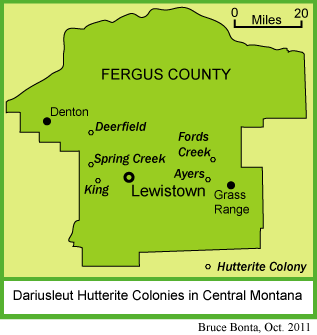The Great Falls Tribune reported last Thursday that the National Geographic Channel has started preparing a documentary film about a central Montana Hutterite colony, a project that may have been inspired by a Montana artist nearly four years ago.
 In January 2008, artist Cheryl Bannes, from Lewistown, Montana, hatched the idea of distributing 50 disposable cameras to Hutterite children in the surrounding colonies. With the permission of colony elders, the aim of the project was to inspire the children to take pictures of the ordinary things of life. The kids recorded people picking berries, riding horses, swimming, and so on. The idea was to inspire the children to record events in their colonies through their own eyes.
In January 2008, artist Cheryl Bannes, from Lewistown, Montana, hatched the idea of distributing 50 disposable cameras to Hutterite children in the surrounding colonies. With the permission of colony elders, the aim of the project was to inspire the children to take pictures of the ordinary things of life. The kids recorded people picking berries, riding horses, swimming, and so on. The idea was to inspire the children to record events in their colonies through their own eyes.
The resulting photos—1,200 were submitted—were juried by Ms. Bannes and a committee of parents and a teacher. The best 36 shots were then displayed in an exhibit that was shown in various Montana museums.
All six colonies involved in the project are from the Dariusleut group, and five of the six are located in the greater Lewistown area. The five are the Ayers Colony near Grass Range; the Deerfield Colony near Denton; the Fords Creek Colony, near Grass Range; the King Colony near Lewistown; and the Spring Creek Colony near Lewistown. The sixth, the Loring Colony, is near the Canadian border, 140 miles northeast of Lewistown.
The news story last week did not identify which colony was being filmed by National Geographic, except that it is Dariusleut, is located in the Lewistown area, and it has 59 members. Evidently, the National Geographic crew started filming life at the colony several weeks ago.
Jeff Collins, director of production at the National Geographic Channel, indicated that the Hutterites will tell their own stories, without outside narration. The footage will be used in a ten-part series, to be aired sometime in 2012, and tentatively titled “One Big Family: The Hutterites.”
Since the colony members themselves will do all the talking, there is not likely to be a lot of unwanted, inaccurate dramatization, such as the films that have plagued the Amish. The recent Lifetime Movie Channel film “Amish Grace” seriously distorted Amish values, according to many critics. The forthcoming Hutterite series will focus on the day to day lives of the people. Collins says the filming focuses on just the one individual colony, and does not attempt to generalize about the Hutterites as a whole.
“[The colony] is taking somewhat of a risk by doing it this way, and there may be some Hutterites who don’t agree with the way they tell their story,” he indicated. “[But] I think the show is going to be amazing—no one has ever had this kind of access before.” He said that some viewers may be surprised to learn how the colony members deal with problems.
He added that the colony does, of course, have problems and issues that they have to handle, like any other group of people. He said that they deal with their problems whenever they arise, rather than letting them fester, as other groups may do.
One of the issues the colony faces is how much modern technology to accept and how to incorporate it into their lives. One person told Mr. Collins, “our grandparents used to plow these fields with horses and plows and now we do it with modern tractors that have air conditioning and a GPS satellite system, so yes, we have evolved, and in a way that’s what is necessary for us to survive.”
It is not clear whether the cameras in the hands of the school children nearly four years ago inspired this latest attempt to make information about the Hutterites available to a wider public. Despite very different approaches, the two projects have somewhat similar goals.